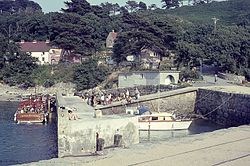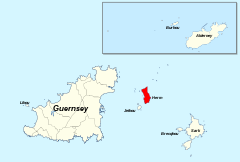Herm
| Herm | |
 Herm Harbour in 1968 | |
|---|---|
| Location | |
| Location: | 49°28’0"N, 2°27’0"W |
| Area: | 300 acres |
| Data | |
| Population: | 60 (2002) |
Herm is an island within the Bailiwick of Guernsey. It is the smallest of the Channel Islands that is open to the public, though cars are banned from the small island just as they are on its neighbour, Sark. Unlike Sark, bicycles are also banned, though resident islanders are permitted the use of quad bikes and tractors for the locals.
The island's name in Guernésiais is Haerme. It is not an autonomous island within the Bailiwick, as Alderney and Sark are, but is directly under the authority of the States of Guernsey. Indeed the States own the island, having bought Herm from the Crown after the War in order that the island could be enjoyed by the people of Guernsey.
Herm won the 2002 and 2008 Britain in Bloom competition in the 'Small Coastal Resort' category.
Contents
History
Herm was occupied in prehistoric times; the remains of Neolithic chamber tombs have been found on the island, but know history begins only in the Middle Ages.
Middle Ages
The first records of Herm's inhabitants in historic times are from the 6th century, when the island became a centre of monastic activity]]; the name 'Herm' supposedly derives from hermits who settled there, although an alternative interpretation derives Herm from the Old Norse erm, meaning "arm", referring to an arm-like appearance of the island. The monks suffered from the inclement weather and storms off the sea however; in 709, a storm washed away the strip of land which connected the island with the small uninhabited island of Jethou.
The most important moment in Herm's political history was 933, when the Channel Islands were annexed to the Duchy of Normandy created by the Norse and Danes. After the annexation, Herm gradually lost its monastic inhabitants, and between 1570 and 1737 it was used as a hunting ground by the governors of Guernsey.
19th century to 1940
In the 19th century, industry arrived in Herm with the establishment of granite quarries to serve the large scale military fortifications undertaken in the islands. The island was let to tenants by the Crown and was generally off-limits to visitors. When Prince Blücher and his British wife leased the island from the British government in the years before the during the First World War, and he introduced a colony of wallabies to the island.[1] None now survives.
Between 1920 and 1923, the prolific writer Compton Mackenzie was tenant of the island; among his best known works are The Monarch of the Glen and Whisky Galore.
Second World War
On 25 July 1940, a few weeks after the arrival of German troops in Guernsey and Jersey, nine German soldiers landed on the island in a commandeered motor boat to shoot a propaganda film. They went back to Guernsey the same day. Herm's sandy beaches were soon used for practising landings from barges, in preparation for the invasion of Britain, but otherwise the island saw little of the Germans beyond officers making trips to shoot rabbits. Herm was spared the huge concrete blockhouses, anti-tank walls and observation towers that were built on the larger islands.
Operation Huckaback, a British commando raid, was planned for the night of 9/10 February 1943 as a simultaneous raid on Herm, Jethou and Brecqhou to take prisoners and gain general information about the situation in the occupied Channel Islands, but was cancelled because of bad weather. Huckaback was reinvented as a raid on Herm alone on the night of 27/28 February 1943. Ten men of the Small Scale Raiding Force under Captain P A Porteous (VC) landed 200 yards to the north-west of Selle Rocque on a shingle beach and made three unsuccessful attempts to climb the cliff in front of them. Porteous finally managed to climb up the bed of a stream and pulled the others up with a rope. On reaching Belvoir House, they found it broken into and abandoned. The Old Tower of Herm and the Chateau were also deserted. They later reported that they had found no sign of any Islanders or Germans (who were supposed to be billeted near the harbour).
1945 to the present day
After the war, the States of Guernsey decided to buy Herm from the Crown in order that its pleasant atmosphere could be enjoyed by Guernsey residents. The States now rent the island to a tenant, who is expected to maintain the island for the benefit of its visitors.
The most influential tenant has been Major Peter Wood, who looked after the island from 1949 to 1980, after which Adrian and Pennie Wood Heyworth took over. Major Wood died in 1998.
It was reported by BBC News and ITV Channel Television on 17 May 2008 that the tenants had put the remaining 40 years of their lease up for sale, with an asking price of £15,000,000. In September 2008 it was announced that Starboard Settlement, a trust, had acquired the remainder of the lease for considerably less than the asking price.[2] The trust formed a Guernsey company, Herm Island Ltd, to manage the island for the trustees.
Placenames
The Herm Island map, published by the tenant of Herm says -
The origins of many of the place names in the island are obscure, as indeed is the name 'Herm' itself
Over the years, there has been a steady Anglicisation of the island's remaining Norman-French names, for example the northern tip of the island is properly called "La Pointe du gentilhomme" but is often referred to as "Alderney Point".
Fieldnames are generally English, with the following exceptions - "Monku", "Belvoir", and "Bon Jour". Remnants of Old Norse are scanty, but examples would be the second element of Pointe Sauzebourge on the south west tip of the island, while the rock of "Le Plat Houmet" contains the -hou element (the Norse holmr, meaning island) with a Norman diminutive.
Geography and geology
Herm is only 1½ miles long and less than half a mile wide. It is oriented so that its greatest length runs north-south. The northern half of the coastline is surrounded by sandy beaches, the southern half is rocky.
Shell Beach and Belvoir Bay are two of the major tourist attractions.
The isle of Jethou is just to the south. It is said that in 709 AD a storm washed away the strip of land which connected the island with Herm.[3]
To the west is the channel Little Roussel (Petit Ruau) between it and Guernsey, and the Big Roussel (Grand Ruau) to the east, between it and Sark.
Much of Herm's bedrock is granite.
Economy and buildings
Tourism is Herm's main source of income, with the majority of tourists arriving on one of the Trident catamaran ferries from Guernsey. On some busy days, the Herm Clipper is also called into service. Herm contains the historic White House hotel.
Money is also made from vegetable growing, livestock and occasionally issuing its own stamps.
Outside links
- Official website of Herm
- Herm, Channel Island website
- Major Peter Wood – The Independent 'obit'
- Blue Islands – Airline servicing the Bailiwick of Guernsey
- Ralph Phillips. Modern British Locals Catalogue. Part I [CD-ROM] (title from CD-ROM label). [S.l.]: British Locals Philatelic Agency, 2009.
References
- ↑ Blücher, Evelyn. An English Wife in Berlin. E. P. Dutton & Company, 1920, p. vii.
- ↑ New Herm tenants vow to keep it open to all >> Herm >> News >> This Is Guernsey
- ↑ Herm Home Page
| The Channel Islands |
|---|
|
Bailiwick of Guernsey: Guernsey • Alderney • Sark • Herm • Brecqhou • Burhou • Ortac • Les Casquets • Jethou • Lihou • Crevichon • Les Houmets |
|
Bailiwick of Jersey: Jersey • Les Écréhous • La Motte • Les Minquiers • Pierres de Lecq • Les Dirouilles |




